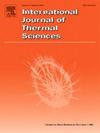Understanding the coupled thermo-electro-osmotic transport in asymmetrically charged nanochannels
IF 4.9
2区 工程技术
Q1 ENGINEERING, MECHANICAL
International Journal of Thermal Sciences
Pub Date : 2025-03-27
DOI:10.1016/j.ijthermalsci.2025.109872
引用次数: 0
Abstract
Nanofluidic thermo-diffusion, encompassing both thermo-electric and thermo-osmotic effects, is gaining increasing attention for applications in low-grade thermal energy conversion, bio-molecular sensing, charge separation, and desalination. However, the influence of asymmetric surface charge density in thermally-driven nanochannel configurations has remained largely unexplored. This study presents a computational investigation using the extended Nernst–Planck–Poisson–Navier–Stokes and energy equations to examine the effects of Debye length and surface charge configurations (unipolar vs. bipolar) on thermo-electro-osmotic characteristics in nanochannels. Two electrolyte solutions, NaCl and NaI, were assessed, with a focus on ion-specific thermophobic and thermophilic behaviors. The results reveal that unipolar channels show a strong dependence on the Debye length, with significant effects on short-circuit current and Seebeck coefficient, while bipolar configurations exhibit rectified and monotonic behavior that is largely independent of surface charge density. Thermo-osmotic coefficients, evaluated under both short- and open-circuit conditions, demonstrate that bipolar channels accumulate responses with decreasing Debye length, contrasting with the discrete shifts observed in unipolar channels. The superior thermophoretic properties of in NaI solutions consistently lead to higher performance compared to NaCl, particularly in specific bipolar configurations. These findings underscore the critical role of surface charge polarity and ionic mobility in influencing the magnitude and direction of thermo-electro-osmotic responses, highlighting the potential of asymmetric nanochannels to achieve controlled ionic transport and rectification. This work provides essential insights for the design of next-generation nanofluidic devices and advances our understanding of thermally-driven transport phenomena in nanofluidic systems.

了解不对称电荷纳米通道中耦合的热-电渗透传输
纳米流体热扩散技术包括热电效应和热渗透效应,在低品位热能转换、生物分子传感、电荷分离和海水淡化等领域的应用越来越受到关注。然而,不对称表面电荷密度对热驱动纳米通道结构的影响在很大程度上仍未被探索。本研究利用扩展的能思特-普朗克-泊松-纳维-斯托克斯方程和能量方程进行了计算研究,以检验德拜长度和表面电荷构型(单极与双极)对纳米通道中热电渗透特性的影响。对两种电解质溶液NaCl和NaI进行了评估,重点研究了离子特异性的疏热和亲热行为。结果表明,单极通道表现出强烈的依赖于德拜长度,对短路电流和塞贝克系数有显著影响,而双极通道表现出整流和单调行为,在很大程度上与表面电荷密度无关。在短路和开路条件下评估的热渗透系数表明,与单极通道中观察到的离散位移相比,双极通道随着德拜长度的减少而积累响应。与NaCl相比,I−在NaI溶液中优越的热泳特性始终导致更高的性能,特别是在特定的双极性配置中。这些发现强调了表面电荷极性和离子迁移率在影响热电渗透反应的大小和方向方面的关键作用,强调了不对称纳米通道实现受控离子传输和精流的潜力。这项工作为下一代纳米流体器件的设计提供了重要的见解,并推进了我们对纳米流体系统中热驱动输运现象的理解。
本文章由计算机程序翻译,如有差异,请以英文原文为准。
求助全文
约1分钟内获得全文
求助全文
来源期刊

International Journal of Thermal Sciences
工程技术-工程:机械
CiteScore
8.10
自引率
11.10%
发文量
531
审稿时长
55 days
期刊介绍:
The International Journal of Thermal Sciences is a journal devoted to the publication of fundamental studies on the physics of transfer processes in general, with an emphasis on thermal aspects and also applied research on various processes, energy systems and the environment. Articles are published in English and French, and are subject to peer review.
The fundamental subjects considered within the scope of the journal are:
* Heat and relevant mass transfer at all scales (nano, micro and macro) and in all types of material (heterogeneous, composites, biological,...) and fluid flow
* Forced, natural or mixed convection in reactive or non-reactive media
* Single or multi–phase fluid flow with or without phase change
* Near–and far–field radiative heat transfer
* Combined modes of heat transfer in complex systems (for example, plasmas, biological, geological,...)
* Multiscale modelling
The applied research topics include:
* Heat exchangers, heat pipes, cooling processes
* Transport phenomena taking place in industrial processes (chemical, food and agricultural, metallurgical, space and aeronautical, automobile industries)
* Nano–and micro–technology for energy, space, biosystems and devices
* Heat transport analysis in advanced systems
* Impact of energy–related processes on environment, and emerging energy systems
The study of thermophysical properties of materials and fluids, thermal measurement techniques, inverse methods, and the developments of experimental methods are within the scope of the International Journal of Thermal Sciences which also covers the modelling, and numerical methods applied to thermal transfer.
 求助内容:
求助内容: 应助结果提醒方式:
应助结果提醒方式:


